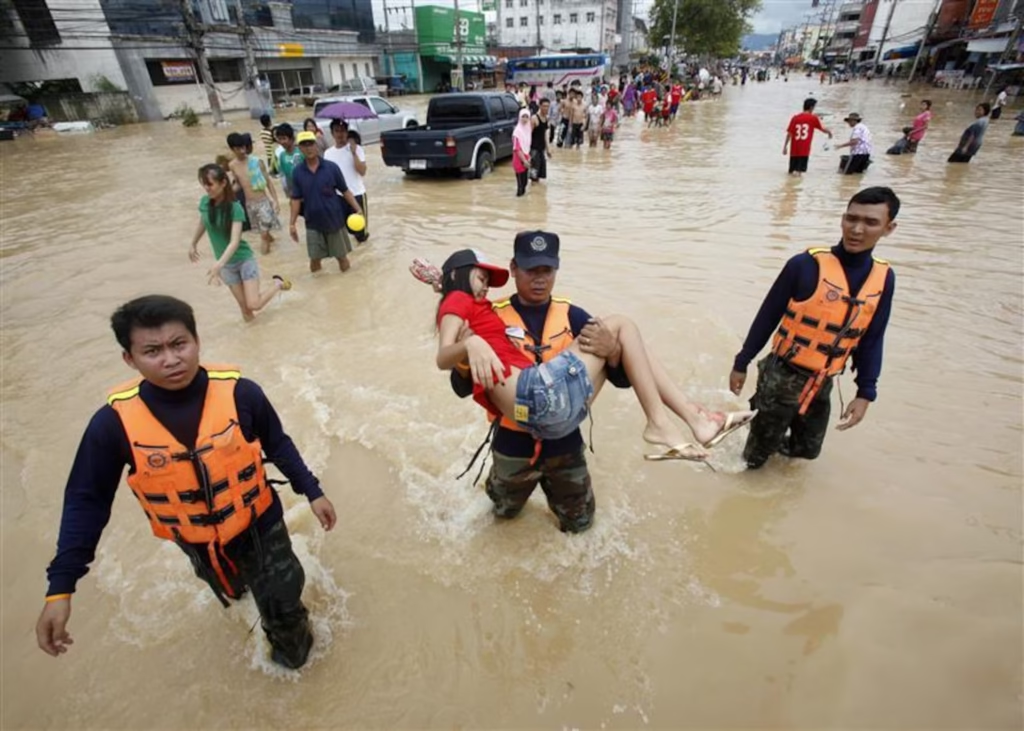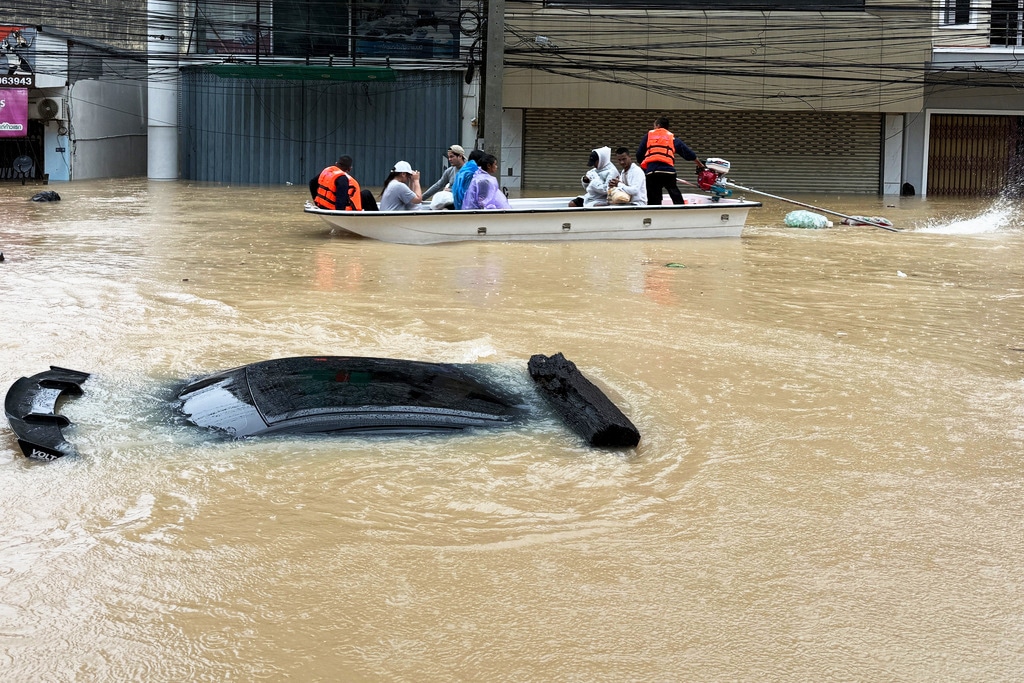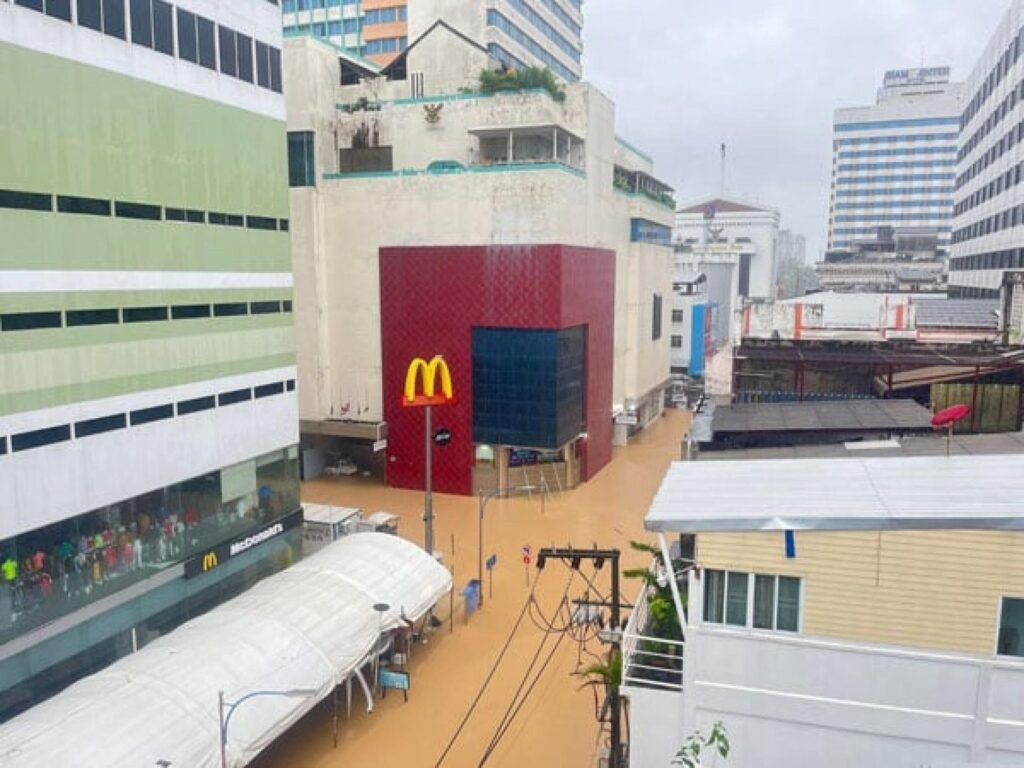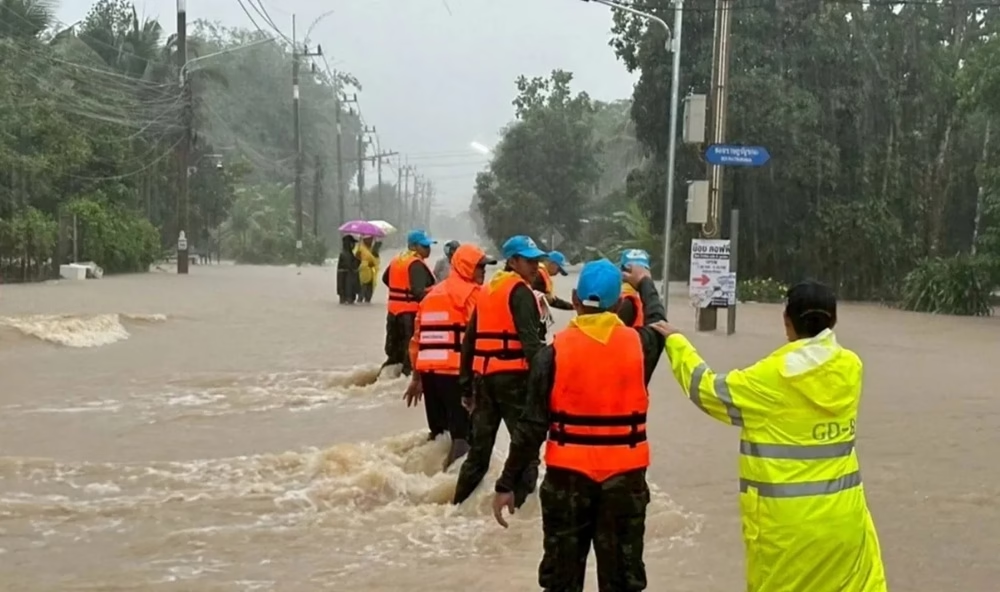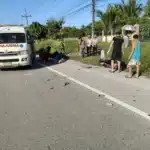HAT YAI, Songkhla – In a drastic step on Monday afternoon, Songkhla Governor Jessada Jitrat ordered all residents to evacuate Hat Yai municipality and nearby areas, as days of heavy monsoon rain turned the main commercial hub of southern Thailand into a vast pool of water.
By evening, many neighbourhoods were under 50 centimetres to 2.5 metres of floodwater, and officials warned that levels could climb by another 50 centimetres by midnight and reach 1.25 to 1.45 metres by 6 a.m. on Tuesday.
Speaking at an emergency press briefing at the flooded provincial hall, Governor Jessada declared Hat Yai district a disaster zone and urged anyone still at home to get out at once.
“This situation is now beyond control,” he said. “Water levels are still rising fast. For the safety of everyone, we have ordered a full evacuation of Hat Yai municipality and all low-lying sub-districts. No one should remain in their home.”
Military and Rescue Units Battle Rising Floodwaters
As the evacuation order took effect, hundreds of soldiers from the 42nd Military Circle and the Royal Thai Army Task Force joined disaster-response teams, police, and local volunteers in a large-scale rescue effort. Amphibious trucks, high-clearance army vehicles, and flat-bottomed long-tail boats became the only way to reach thousands of people still trapped in flooded streets and houses.
In the municipal market zone and along Niphat Uthit 3 Road, soldiers waded through waist-deep muddy water, lifting elderly residents onto their backs and carrying them to waiting boats. In Ban Phru and Khlong U Taphao, whole families, including babies and bedridden relatives, were moved under torchlight as power failed across large parts of the city.
“I have lived here for 78 years and never seen anything like this,” said Aunty Noi, 78, clutching a small bag of belongings as soldiers lifted her wheelchair into a boat. “The water rushed into the house so quickly. We did not even have time to save the fridge.”
By 8 p.m. on Monday, more than 12,000 people had been taken to 28 temporary shelters set up in schools, temples, and government buildings on higher ground. Officials said the total number of evacuees could rise above 80,000, close to half of Hat Yai’s population.
U Taphao Canal Bursts Its Banks as Rain Keeps Falling
Meteorologists linked the disaster to days of unbroken heavy rain since last Wednesday, combined with overflow from the U Taphao Canal, the main drainage channel for Hat Yai. The canal, clogged by years of silt and rubbish, spilled over in several sections on Sunday night, sending a surge of water into housing estates and business districts.
The Thai Meteorological Department reported that Hat Yai had received 412 millimetres of rain in the last 72 hours, almost equal to the average rainfall for the whole of November. Forecasters expect more rain through Wednesday, as an active monsoon trough remains over the lower southern region.
At 7 p.m. on Monday, the water gauge at Prince of Songkla University in central Hat Yai registered 2.1 metres above street level, already higher than the infamous 2010 flood that shut down the city for weeks. Weather experts warned of further rises overnight, as runoff from upstream areas in Phatthalung and water from the saturated Sankalakiri mountain range continued to flow into the Hat Yai basin.
Hat Yai Shops Count Heavy Losses
Hat Yai’s famous night markets, malls, and the ASEAN Trade Bazaar now lie silent under deep, murky water. Major routes, including the Asian Highway (Phetkasem Road), Kanchanawanit Road, and the railway line to Malaysia, are all underwater and closed to traffic. Hat Yai International Airport has suspended all flights until at least Wednesday.
At the Big C Extra supermarket on Kanchanawanit Road, staff watched helplessly as water climbed above the second floor.
“Everything has been destroyed,” said store manager Somchai Boonpeng. “Freezers, stock, tills, all of it is under water. We have no idea when we can start again.”
In badly affected communities like Suan Tul, where the water reached the rooftops of some single-storey houses, residents who had refused to move earlier are now begging to be rescued. Mobile networks have gone down in several parts of the city, leaving people struggling to reach loved ones.
Race to Help Those Most at Risk
Rescue teams say many of those still stuck in flooded homes are older people, bedridden patients, or those with long-term illnesses who could not be moved during earlier voluntary evacuations.
Hat Yai Hospital is surrounded by around 1.5 metres of water, and staff worked through the night to move critical patients by boat to Songkhla Nakharin Hospital, escorted by navy crews.
“We have patients on oxygen, people who need dialysis, and others on ventilators,” said hospital director Dr Uthai Kao-ian. “Every transfer carries risk, but staying here is not an option.”
As midnight nears, the noise of boat engines and the shouts of rescuers echo along the dark, flooded streets of Hat Yai. Volunteers from the Red Cross and the Ruamkatanyu Foundation carry out house-to-house checks with torches, knocking on gates and calling out for anyone still inside.
Hat Yai has faced serious floods in 1988, 2000, 2010, and 2017, yet long-term residents say they are shocked by how fast this disaster has unfolded. Many people fear that if the predicted rise of up to 1.45 metres comes by dawn, large parts of the city could stay underwater for weeks.
Governor Jessada has called for urgent help from the Prime Minister’s Office and the Royal Thai Armed Forces. More troops, rescue boats, and heavy machinery are expected to arrive on Tuesday morning.
For now, the people of Hat Yai can only wait, some in crowded shelters, others on the upper floors of flooded homes, watching the water levels and hoping they will start to fall before sunrise brings what may be the city’s hardest day in a generation.





